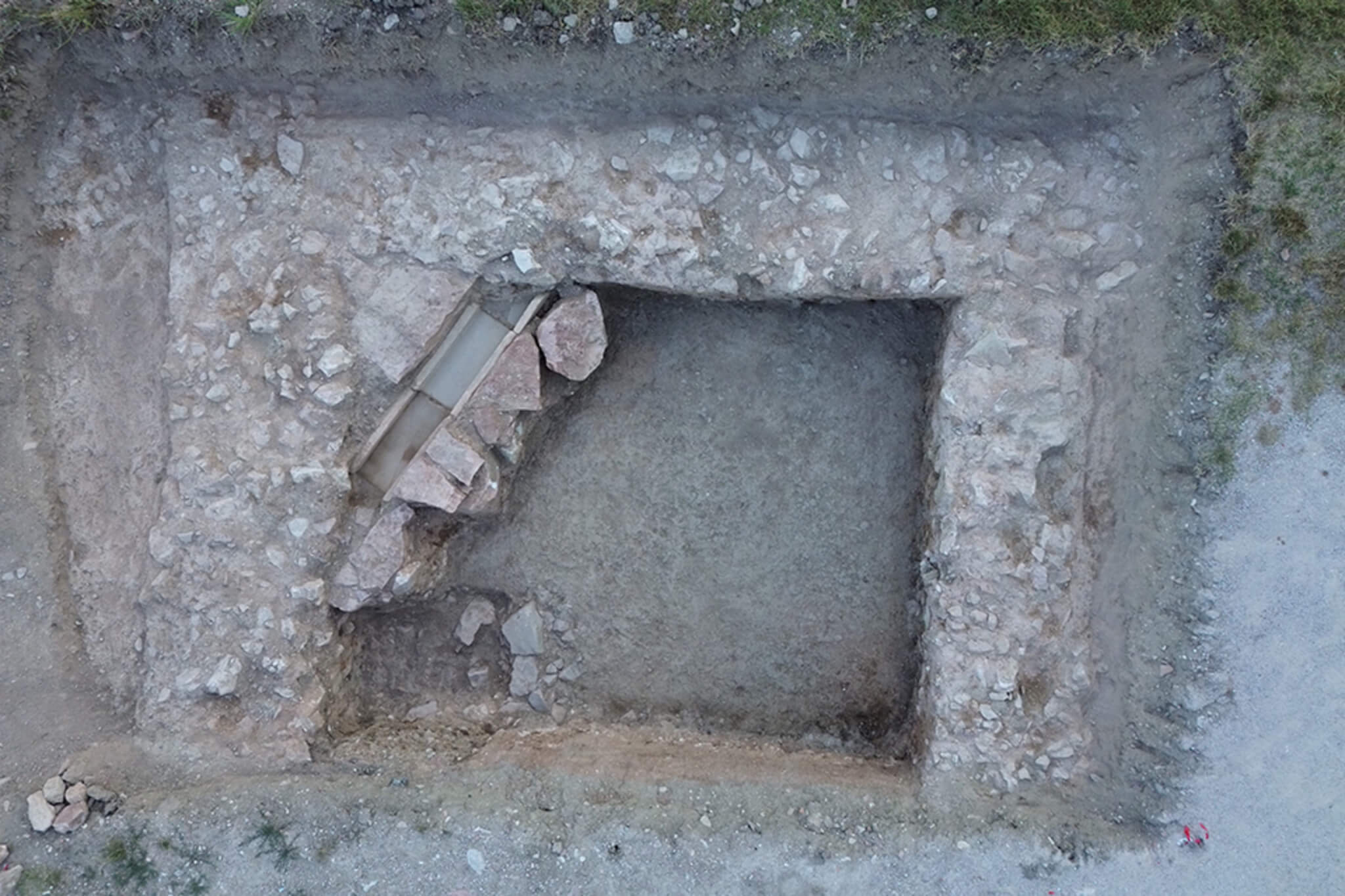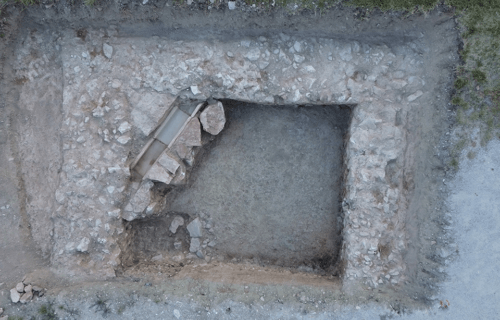ST. LOUIS — Beneath the modern-day streets of Italy, hidden under a parking lot, lies a discovery that challenges our understanding of one of history’s pivotal transitions: the Roman Empire’s shift from paganism to Christianity. This revelation, made by American researchers, uncovers an ancient temple dating back to the era of Constantine the Great, Rome’s first Christian emperor.
Their findings offer a profound glimpse into a time of cultural and religious flux, revealing a society that was more “multicultural” than previously thought.
At the heart of this discovery is Professor Douglas Boin of Saint Louis University, an expert in ancient Roman religious transitions. The discovery includes three ancient walls, believed to be part of a temple dedicated to the Imperial Cult. This temple, located in the town of Spello, is now considered the largest evidence of the Imperial Cult practice in fourth-century Italy and the late Roman Empire.
Boin’s team, including Dr. Letizia Ceccarelli of Politecnico di Milano, made this monumental discovery during a summer excavation. They revealed their findings at the Archaeological Institute of America’s annual meeting.
“We found three walls of a monumental structure that evidence suggests belonged to a Roman temple that dates to Constantine’s period,” Boin said in a statement, emphasizing the temple’s potential to reshape our understanding of the late Roman Empire’s social and religious landscape. “It would be a remarkable addition to the landscape of this corner of Italy. It will significantly aid in the understanding of the ancient town, the ancient townscape and city society in the later Roman Empire because it shows the continuities between the classical pagan world and early Christian Roman world that often get blurred out or written out of the sweeping historical narratives.”
What led Boin to the Roman Empire ruins?
Boin was drawn to Spello, a renowned medieval hilltop city, by a rescript—a fourth-century letter from Emperor Constantine to the townspeople. This letter, discovered in the 18th century, revealed a fascinating aspect of multicultural Roman society. It permitted the people of Spello to celebrate a religious festival in their own town, but with a significant condition: they had to erect a temple to Constantine’s divine ancestors, the Flavian family, and worship them.
The discovery of the temple provides concrete evidence of religious continuity between the Roman and early Christian worlds, challenging the notion that societal changes were abrupt. Boin explains, “Things didn’t change overnight. Before our find, we never had a sense that there were actual physical, religious sites associated with this late ‘imperial cult practice.’”

The journey to this discovery was arduous. Professor Boin and his team relied on underground imaging to locate potential ruins beneath a parking lot. Their perseverance paid off, leading to the uncovering of what is believed to be the temple’s inner walls. According to Professor Boin, this temple is the most significant evidence of the Imperial Cult in fourth-century Italy and the late Roman Empire.
‘Staying power of pagan traditions’
Boin’s discovery rewrites the narrative of the Roman Empire’s shift to Christianity. Though Emperor Constantine is known for his conversion to Christianity, it took nearly 70 years for Christianity to become the official religion under Emperor Theodosius. This temple highlights the gradual and complex nature of societal change, emphasizing the persistence of pagan traditions alongside the rise of Christianity.
“This building, in a very radical way on its own, shows us the staying power of the pagan traditions…and it shows us how the Roman emperors continued to negotiate their own values, their own hopes and dreams for the future of the emperor and the Empire without knocking down or burying the past,” Boin reflects on the significance of the find.
The excavation of the full temple is next on Professor Boin’s agenda, promising to further illuminate the nuances of this cultural shift.
“We are on the cusp of giving people a very visible piece of evidence that really upends the neat and tidy ways people think about big moments of cultural change,” he says. “Cultural changes are never as big as we think they are when living through them, and there’s a lot of grey area in between people’s customs and the broader society and culture.”

Any student of history will tell you that Constantine’s era was not a “Christian” era. So this “study” challenges nothing in regard to the multi-religious nature of the Roman empire in Constantine’s time. The only challenging thing about this report is the failure of its authors to study history.
Constantine made his conversion to Christianity in 312 AD after experiencing a vision (not a coincidence). His conversion was most definitely the beginning of ‘The Christian era’, and no changes, even that which are good, happens overnight. It takes time to bury old beliefs, even backwards pagan ones.
It’s highly contested Constantine ever “actually converted” to Christianity. Also Eusebius’ account of the “conflict” on the bridge [by this sign conquer, etc.] was fiction – written many years after the event: Eusebius’ 1st rendition of the conflict doesn’t even mention a religious experience at all.
To Richard L. – I concur.
To John – The Council of Nicea was “Ecumenical” in name only – and is said to have been attended by “Latins” – and almost all other bishops had refused to attend.
This is just not true, there is 0 evidence that Constantine ever converted to Christianity but scant tales he converted on his death bed and was baptized before dying. The depictions of him seeing a cross like you see on any church alter is also suspect, as it is believed he saw a sun wheel or what would later become the symbol of the Knights Templar, it is also a Jerusalem Cross worn by the early Hospitalers. This symbol is know from the Sri Yantra and any Native American medicine wheel and is the natural order of the sun in a year’s time. Anyone involved in an Apollo cult would have known the symbol at the time in the Roman era. Apollo was also venerated in Asia Minor before coming to Greece and Rome. So Constantine’s “vision” was hardly of a new religion.
🙂 🙂 🙂
very nice job !
do you really think you are credible ?
LMAO
I feel the same. This isn’t exactly breaking news. I have never thought that the change from paganism to Christianity was sudden and easily defined. It has always been my understanding that it was gradual and happened over the course of centuries.
Many indications point to Christianity still being a tiny minority in the 4th Century, CE. That the vast Roman Empire was multi-cultural, countenancing a variety of religious practices– including Imperial worship— is a no-brainer. This article brought to you by Captain Obvious…
A great article. It seems as though Dr. Boin has a narrative about the find before a full review. For example:
“We are on the cusp of giving people a very visible piece of evidence that really upends the neat and tidy ways people think about big moments of cultural change…”
Whatever it is that bothers the good Dr. about written histories and our current understanding of cultures and societies in the 3rd – 4th centuries BCE, I hope he gets it off his chest. This wonderful finding does not need a narrative grid of his making to upend the “neat and tidy ways people think”. His bias could ruin a great find.
JPN
“BCE”? Unless I’m missing something, don’t you mean CE? (I miss the old terms, “BC” and “AD.” Less easily confused.)
I can see nothing ‘profound’ in the pictures.
How big is this square hole in the ground? 10 feet… 30 feet… 100 feet?
Yep, how difficult would it have been to have put a meter stick or something in the photo to show the scale?
Well, because you’re supposed to think paganism was grander than it was.
Yes, but 325 AD was the date Constantine ordered the First Ecumenical Council to convene in order to bring peace to the Roman Empire due to the theological issues with Arianism. This marker event showed Constantine’s dedication of bringing change and peace into the Roman society by unifying Christianity for the society’s benefit. The dynamical shift from paganism to Christianity has always been understood with monumental marker events taking place. This find shows that.
Love stories (discoveries) like this. Thank you for sharing it!
This lends credence to the theory that Alexander the Great’s body may indeed repose in St. Mark’s Bascillica, since overtime the rise of Christianity overshadowed the old pagan sites, including the tomb of Alexander in Alexandria, when his tomb morphed into St. Mark’s tomb as a way of protecting Alexander’s pagan body from being destroyed by overzealous Christians..